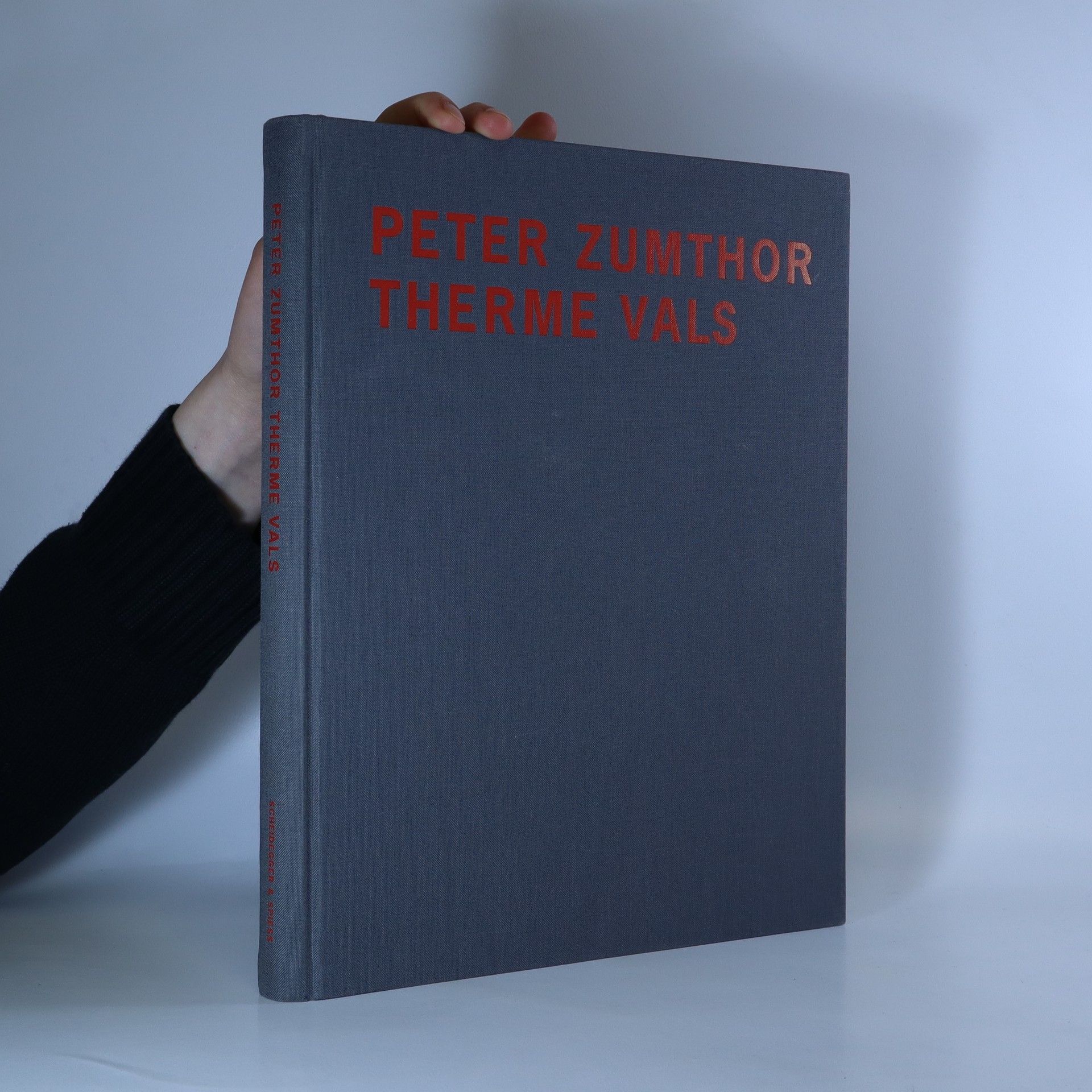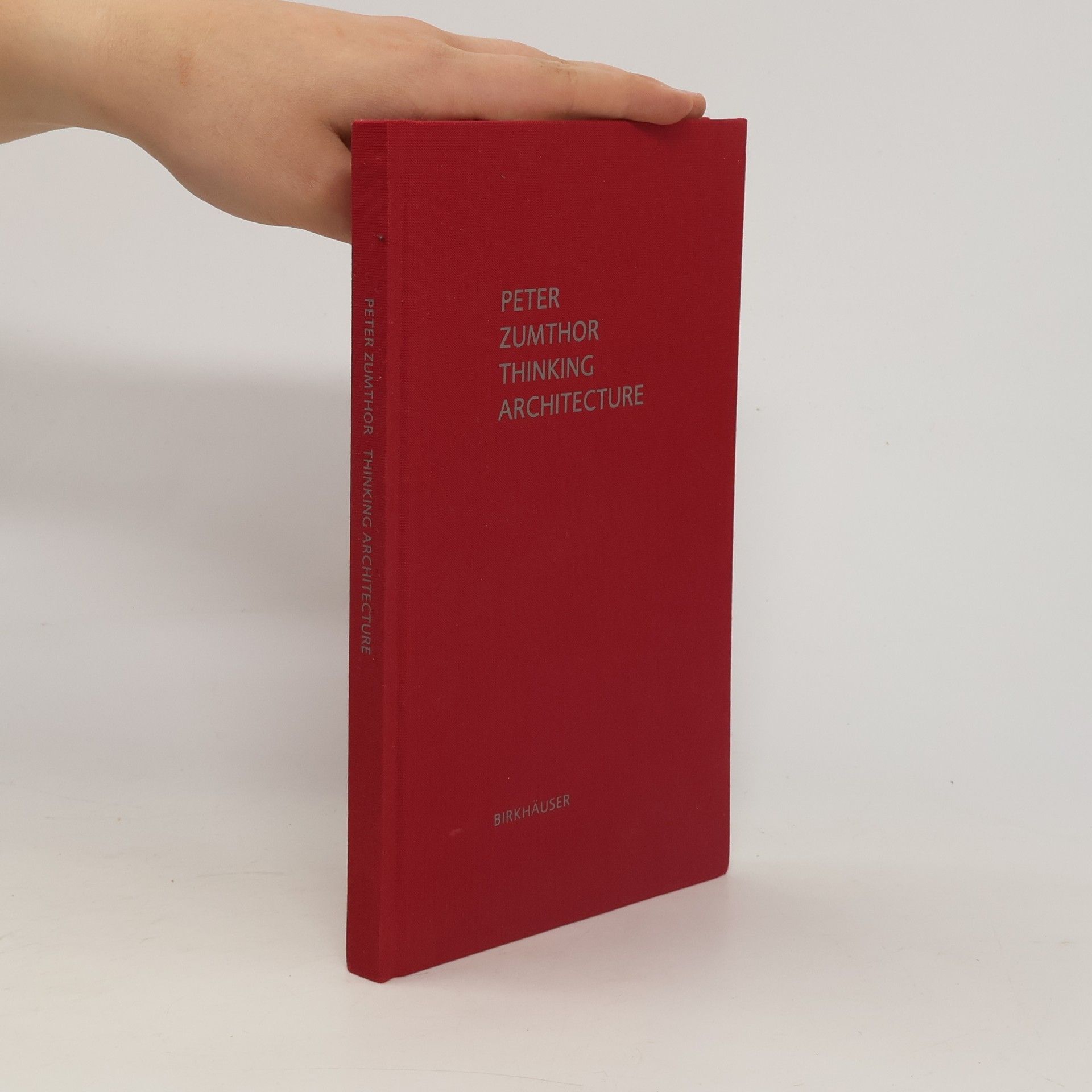What “really constitutes an architectural atmosphere”? Peter Zumthor says, is “this singular density and mood, this feeling of presence, well-being, harmony, beauty ... under whose spell I experience what I otherwise would not experience in precisely this way.” Zumthor’s passion is the creation of buildings that produce this kind of effect, but how can one actually set out to achieve it? In nine short, illustrated chapters framed as a process of self-observation, Peter Zumthor describes what he has on his mind as he sets about creating the atmosphere of his houses. Images of spaces and buildings that affect him are every bit as important as particular pieces of music or books that inspire him. From the composition and “presence” of the materials to the handling of proportions and the effect of light, this poetics of architecture enables the reader to recapitulate what really matters in the process of house design.
Peter Zumthor Knihy
Peter Zumthor je architekt, ktorý sa snaží o to, aby jeho budovy hovorili vlastným jazykom a odolávali kultu povrchnosti. Verí, že architektúra by mala byť premyslenou odpoveďou na konkrétne potreby, miesto a spoločnosť, v ktorých vzniká. Jeho diela, ako napríklad termálne kúpele vo Valși, sú príkladom majstrovského využitia materiálov a svetla na vytvorenie atmosférických priestorov. Zumthor kladie dôraz na jednoduché, ale precízne detaily, ktoré posilňujú celkovú skúsenosť z budovy.







Thinking architecture
Third, expanded edition
Architecture that is meant to have a sensuous connection to life calls for thinking that goes far beyond form and construction. In his texts, Peter Zumthor articulates what motivates him to design his buildings, which appeal to the visitor's heart and mind in so many different ways and possess a compelling and unmistakable presence and aura. Now in its third edition, this book has been expanded to include two new essays: „Architecture and Lanscape” deals with the relationship between the structure and its surroundings, with the secret of the successful placement and topographical integration of architecture. In „The Leis Houses”, Peter Zumthor describes the genesis of two wooden houses in the town of Leis in the Swiss canton of Graubünden, thus thematizing the special challenge of integrating contemporary architecture into a traditional architectural context.
The monograph features the renowned architect's texts, sketches, and drawings, showcasing his creative process and philosophy. It includes new photographs that highlight his architectural works, providing a visual journey through his designs. Additionally, a comprehensive catalog of his projects is included, offering an in-depth look at his contributions to architecture. This publication serves as a significant resource for understanding Peter Zumthor's impact on the field.
Peter Zumthor: Therme Vals
- 192 stránok
- 7 hodin čítania
The beginning was easy. Going back in time, bathing as one might have a thousand years ago, creating a building set into the slope with an architectural attitude older than anything built around it, inventing a structure that could always have existed, one that relates to the topography and geology of the location, responding to the stone masses of Vals Valley—these were the objectives of our design. Peter Zumthor, born in 1943, studied at the College of Applied Arts in Basel and the Pratt Institute in New York. He was awarded the Pritzker Architecture Prize in 2009 for his life’s work, including the Kunsthaus Bregenz and Kolumba Art Museum. His Therme Vals, a spa complex built into a Swiss Alp mountainside, became an icon of contemporary architecture after its 1996 opening. This book-length study features Zumthor’s original sketches and plans, alongside Hélène Binet’s striking photographs. Annotations by Zumthor highlight Therme Vals’s relationship with its natural surroundings, while an essay by architectural scholar Sigrid Hauser explores connections between the spa’s elemental nature and themes of mythology, bathing, and purity. This lavishly illustrated volume will captivate enthusiasts of contemporary design.
Since completing the thermal bath in Vals/ Graubünden (1996) and the Museum of Fine Arts in Bregenz/Austria, Peter Zumthor has become one of the most renowned architects in Europe. His buildings and projects inspire enthusiasm with their peerless exactitude, their poetry and a radical, independent aesthetics and vocabulary of forms. This publication is the first complete survey of Peter Zumthor’s oeuvre. The book presents his eight buildings (1986–1997), with a photo essay by Hélène Binet. The descriptive commentaries were written by Peter Zumthor himself.
Completed in 1997, the Kunsthaus Bregenz is clad in glass panels. During the day, it is a semi-transparent glass structure, while at night it becomes a thirty-meter-high glowing cube, a statement in light. The interior of the building - a stack of three rooms offering an exhibition space of 1,800 square meters, with a highly sophisticated air-conditioning system that both heats and cools - is constructed in smooth concrete, terrazzo, matt glass, and indirect natural light. This reprint of the monograph from the Werkdokumente series presents the architecture of Zumthor's museum with texts by Friedrich Achleitner and the architect himself, as well as with floor plans and photographs by Hélène Binet.
Swiss sound box
- 300 stránok
- 11 hodin čítania
Die Schweiz präsentierte sich auf der EXPO 2000 in Hannover mit einer ungewöhnlichen Holzstruktur des Architekten Peter Zumthor. Dieser 'Klangkörper Schweiz' beherbergte keine Ausstellung im herkömmlichen Sinne: der Pavillon selbst war das Ereignis. Architektur, Musik, Wort, Modedesign und Gastronomie verbanden sich zu einem Ort der Entspannung, des Genießens und Entdeckens. Da es im Schweizer Pavillon keine Erklärungen oder Verweise gab, wurde für die Gäste dieses Begleitbuch entwickelt. Es gibt Auskunft über nahezu alle Fragen, die sich dem Besucher des Pavillons stellen können, und wirkt so als Bindeglied zwischen dem unmittelbaren 'Erlebnis Klangkörper' und der Realität jenseits des Pavillons. Durch die alphabetisch geordneten Stichworte erhält das Buch einen gezielt lexikalischen Charakter aber auch einen eigenständigen Wert: Es entwickelt sich zu einem außergewöhnlichen 'Vademecum der Schweiz', das einen aktuellen Querschnitt durch die Schweizer Kultur präsentiert.
Three concepts
- 83 stránok
- 3 hodiny čítania
Since the 1980s, Peter Zumthor's buildings have exerted a quiet and autonomous authority within the contemporary architectural landscape. The craftsmanship of his buildings, their physical presence, simplicity and sensitive use of materials create an extraordinary impression. All of Zumthor's projects proceed from a patient search for a basic composition. So-called structural paintings provide first clues about the design and, at the same time, evoke in themselves a meditative pictorial atmosphere. The publication presents this "world of pre-figurations" with the examples of three new projects by the architect. Conceptual and structural sketches and texts by Zumthor recount the genesis of the Thermal Baths in the mountain village of Vals (opened in 1996), of the art museum in Bregenz (opening in 1997) and the memorial and museum building Topography of Terror in Berlin (planned). A series of plans and photographs of the models or realized buildings complete the documentation.
Peter Zumthor, Pritzker-Preisträger von 2009, ist einer der bedeutendsten Architekten der Gegenwart. Sein Schaffen zeichnet sich durch Präzision und Kompromisslosigkeit aus: sorgfältige Abstimmung der Gebäude auf ihren Ort und Gebrauch, die Wahl der Materialien, die atmosphärische Qualität der Räume. Die umfassende Werkübersicht in fünf Bänden präsentiert 43 Bauten und Projekte – darunter zahlreiche, die bisher noch nie gezeigt wurden. Sie bietet eine Dokumentation seiner weltbekannten Gebäude und zahlreicher noch nie vorgestellter Projekte auf 856 Seiten, mit über 750 Fotografien, Plänen, Handskizzen, Zeichnungen, Aquarellen und eigens für diese Monografie verfassten Texten von Peter Zumthor. Mit Fotografien von Hélène Binet, Hans Danuser, Ralph Feiner, Thomas Flechtner, Walter Mair, Joël Tettamanti und anderen. Ausgezeichnet mit dem Filaf d'argent 2014 (Festival International du Livre d'Art & du Film). Ausgezeichnet mit dem DAM Architectural Book Award 2014. Gestaltet von Beat Keusch Visuelle Kommunikation, Basel – Beat Keusch, Angelina Köpplin.